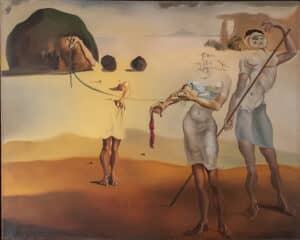Dreaming at the Dali begins Friday


Salvador Dalí; Enchanted Beach with Three Fluid Graces, 1938; Oil on canvas, 25.6 in x 32. Collection of The Dalí Museum, St. Petersburg, FL
Dream imagery was a major component of Salvador Dali’s Surrealist paintings, so it’s only logical that the Dali Museum would take the subject matter and run with it for its latest exhibit.
Opening Friday, The Shape of Dreams includes works by Frida Kahlo, Paul Delvaux, Pat Steir, Philip Guston, Max Beckmann, Lodovico Carracci, Luca Giordano, Odilon Redon – and Dali himself, on loan the National Gallery of Art, Detroit Institute of Arts, The New Orleans Museum of Art, Saint Louis Art Museum and others.
“We’re guiding viewers through this exhibition to heighten awareness of their own dreams,” explained Hank Hine, the museum’s executive director, during a Tuesday preview. “And to understand historically, through five centuries of European and American art, how dreams have been portrayed.
“Where do they come from? Where do dreams originate? What use are they? Do we learn things about ourselves and about others? Is it possible for them to reform any ideas that we may have held prejudiciously?
“And just as Salvador Dali drew on dreams to shape his paintings, we are looking at these five centuries of works to understand how our dreams shape our imaginations.”

Paul Delvaux, The Fire; 1945 Oil on canvas, 76.5 in x 90.75 in, Collection of Saint Louis Art Museum, Bequest of Morton D. May, 880:1983; © 2022 Foundation Paul Delvaux, Sint-Idesbald – ARS/SABAM Belgium
The Shape of Dreams is divided into five section: The Source of Dreams, The Nature of Dreams, Art as a Form of Dreaming, Visions and Nightmares, and The Use of Dreams. The style and methodology changed over the centuries – 20th Century abstract art contrasts with the realism and Deism of the paintings from hundreds of years previous. The subject matter, regardless of form, is the same: What does it all mean?

Domenico Feti Jacob’s Dream c.1613-1614 Oil on wood panel 23.8 in x 17.1 in Detroit Institute of Arts, Founders Society Purchase, General Membership Fund, 39.669 USAPhoto: © Detroit Institute of Arts, USA/Bridgeman Images
A separate gallery section includes quotes – artistically painted on the walls, of course – from a wide range of interpreters and deep thinkers, from Freud and Yung to Shakespeare and Woolfe.
Then there’s an Artificial Intelligence (AI) component, called the “Dream Tapestry.” Visitors are encouraged to follow prompts and reveal moments from their own recurring dreams. Every few minutes, the computer creates a “painting,” a tapestry weaving together interpretations of several visitor dreams at the same time.
Adding AI and other technology is, of course, big on Hine’s agenda for the Dali as it moves comfortably into the 21st century. It’s not the first such innovation for the museum – and if he has anything to say about it,it’ll be far from the last.
“We’ve taken from Dali himself – his love of technology, and his sense of its ability to advance an artistic vision,” Hine said.
“We live in a mediated world, and it’s harder and harder for people to experience things without that mediation. If you think of art as a communicative expression that brings people closer, we want to accelerate that and bring them closer and closer through these interactive experiences.”
He’s not saying the media-saturated public can’t appreciate art without some sort of “dumbed-down” video screen. “I think we can enhance their experience through technology. And even if you took an audience from the past … for instance, Dali was the first artist to use video as a work of art, and it brought an immediacy, even to his audience in 1959.
“So I don’t think people are unable to ‘read’ art – but I think it enhances their experience of it.”
The Shape of Dreams opens Friday, Nov. 25 and will run through April 30.

Frida Kahlo Tunas (Still Life with Prickly Pear Fruit) 1938 Oil on tin 7.75 in x 9.75 in Private Collection, USA © 2022 Banco de México Diego Rivera Frida Kahlo Museums Trust, Mexico, D.F. / Artists Rights Society (ARS), New York







